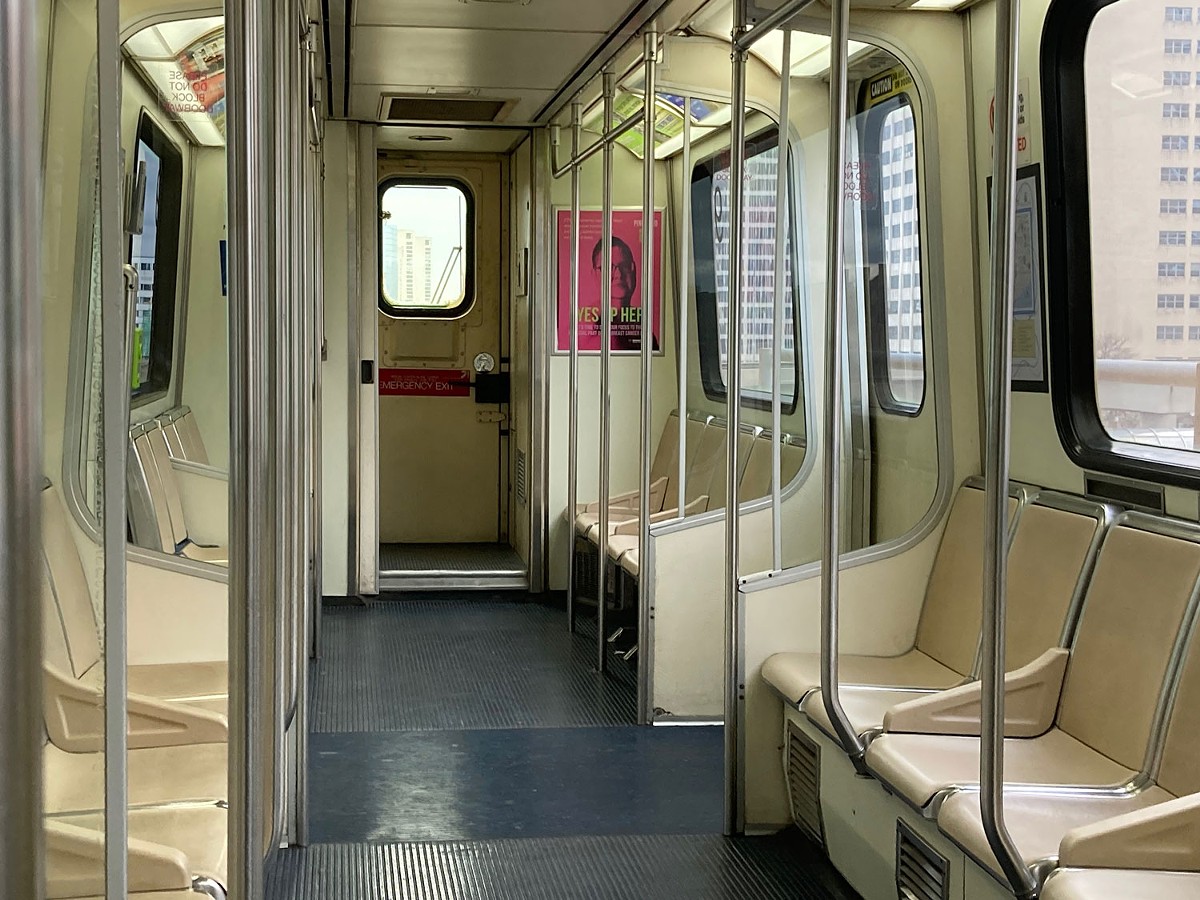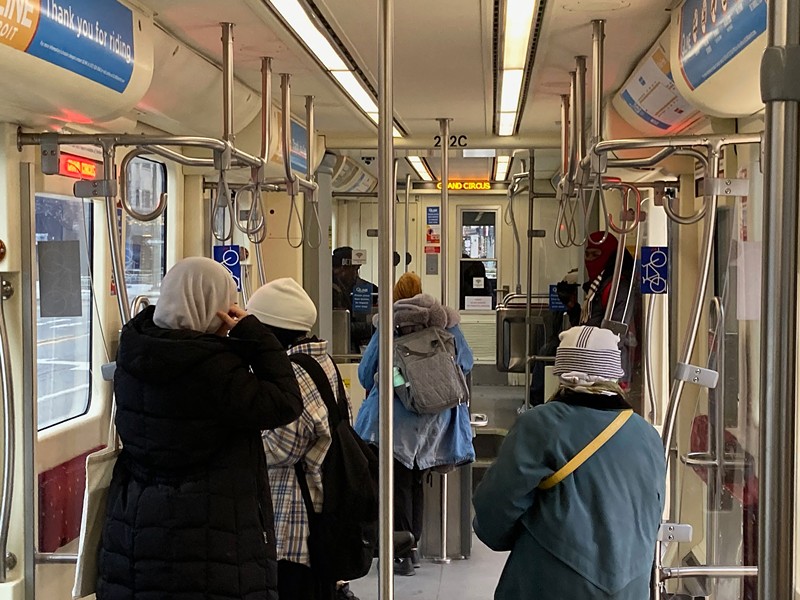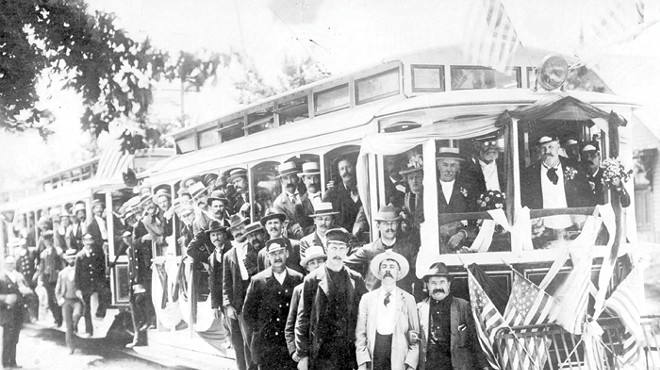In a clean and tidy Detroit People Mover car on a gloomy Monday afternoon, the mood was quiet and peaceful because the compartment was totally empty.
After my 75-cent sky-ride chugged counter-clockwise past Huntington Place station and then above the cloud-shrouded Detroit River, it eventually pulled into the Greektown station, where a middle-aged, female security guard entered in full uniform.
Suddenly, she enforced upon me her unquestioned authority with the full force of the law.
“Hey, love!” she said with a smile.
Let me assure you that in 25 years of riding public trains, buses, and ferry boats in the New York City area, no mass transit worker in that testy megalopolis ever addressed me in this manner! I smiled back and nodded. My trip was off to a good start.
One of my first childhood memories is of riding a Detroit street car along East Jefferson to downtown in the mid-1950s. So I decided to sample our current downtown transit system because Dan Gilbert recently declared that the Detroit area needs a regional rapid transit system.
Of course, he is right. It should have been built a century ago. Gilbert — a major Motor City mover and shaker from the mortgage and real estate world — said young people of the current century prefer not to own cars.
He said good public transit would make this declining region more attractive to businesses and home-buyers and Gilbert is right about that, too.
“Just think how great that would be if you have lines going to Metro Airport, up Woodward, all the way to Pontiac and then going west and then going east,” Gilbert said at a Free Press breakfast event. “It would be unreal. It would be a different city.”
My Monday transit experience changed at Grand Circus Park after I descended from the elevated, 36-year-old, 2.9-mile People Mover loop to street level on Woodward Avenue. There, I caught the QLine, a seven-year-old Gilbert trolley creation that used to charge riders but now carries them for free as a 3.3-mile shuttle between just north of City Hall and the New Center.
Perhaps because there was no charge and the air outside was chilly, the majority of seats were filled by quiet commuters. But when one loud fellow boarded, he strode past me toward the driver’s booth and announced to no one in particular “I should just bust in there and drive this motherfucker myself!”
As he flopped into a nearby seat, he laughed at great volume, perhaps to assure all listeners that he was just kidding about the hijacking.
When an acquaintance joined him at the next stop on the northbound track, his mood shifted and he began to tell his friend his tale of woe in an annoyed rant you could hear a dozen rows away.
“Lost my mother-fuckin’ phone,” he declared. “All my mother-fuckin’ numbers. All my mother-fuckin’ pictures.” (Wonder if any of those photographs are of his mom?)
They say “where there’s a will, there’s a way.” But around Detroit, I fear there is little will to build a real mass-transit system.
tweet this
This continued until just south of Wayne State University, where both men got off and joined a group on the sidewalk in front of a building. The rest of the ride was uneventful and pleasant. I rode both ways and took photos of charming, old buildings and interesting, modern storefronts.
As for the bigger picture, they say “where there’s a will, there’s a way.” But around Detroit, I fear there is little will to build a real mass-transit system, despite an already-established street layout of “spokes on a wheel” that would be ideal for rail lines, even at ground level.
Big avenues like Woodward, Michigan, and Gratiot already have center medians for many miles deep into the suburbs.
Theoretically, in the best-case scenario, rail lines would encourage investors to build places to live, shop, dine, and work within walking distance of train stops, allowing people to live daily lives without taking their motor vehicle with them at all times.
Such warm imaginings might get chilled around here by at least two, cold realities. One is funding, of course, and the other is the narrow-minded, limited mentality of the region, which includes past biases and stereotypes we don’t always like to confront or even admit.
The funding, Gilbert said, must come from the federal government with buy-in from dozens of individual governments in a region that encompasses almost 2,000 square miles in the counties of Wayne, Oakland, and Macomb.
Such an infrastructure project in the Detroit area would require at least another decade of Democratic rule not only in Lansing but also in Washington. Such an optimistic parlay is unlikely. And Republicans will fight mass transit with scare tactics. Job losses in the auto industry!
Unlike Detroit, not all regions in the country live as if the only proper middle-class existence is in a single-family home with a big driveway, a lawn, and a two-car garage. In places where people prefer multi-story apartment buildings or row houses, the population density makes mass transit logical and practical.
Aside from New York, I’ve seen this work well in Chicago, where I lived for three years; and in the San Francisco Bay area, where I often traveled; and in Atlanta, where I often visit. Trains in Atlanta take you for just a few dollars directly from the airport across the city and to the suburbs.
Compare that to Detroit Metro Airport, where there are no trains or express buses or even taxi cabs. To get downtown, a visitor must pay for a pricey car service. Such a ride will cost $88 — plus tip. (In addition, although not easy to locate, there also is a FastMichigan 261 bus that you can take downtown for $2 during the normal DDOT pass window of four hours.)
This sort of thing makes a negative impression on a visitor arriving here for the first time. Or for the 10th time. It discourages them. Perhaps another serious factor against mass transit in this region has to do with Detroit’s historic housing patterns of class and race.
Around here, among some people, mass transit is perceived as something for the poor and for racial minorities. One of the reasons the region is so sprawled out is the white flight for the past 75 years to distant suburbs, some of them without sidewalks, approachable only by automobile.
Although local race relations are much improved from decades ago, some people just don’t want to rub shoulders with those not like them and so they use their motor vehicles as protective shells.
It’s easy to ignore that beggar at the red light while encased in your car; it’s harder when he or she is on the sidewalk making eye contact with you as you walk by from the train station to your condo or to the restaurant where you will meet your friends to dine on the patio.
So don’t get your hopes up over Gilbert’s wish list. He is merely a visionary. And those of us who agree with him are also dreamers who can imagine four or five “spoke” lines of rail tracks radiating out from downtown.
The one on Michigan Avenue could go through bustling Corktown all the way through Dearborn and to the airport, as Gilbert suggested, and maybe even to Ann Arbor. A Gratiot line from downtown could get to Mount Clemens in 45 minutes, with maybe 10 stops.
If you want to think really big, these spoke lines could all be joined by a Main Line running across Eight Mile Road from west to east, from Novi to Lake St. Clair. Kind of like Gilbert said. And maybe another one from east to west on Jefferson from the Grosse Pointes in the east to River Rouge in the west.
Or maybe, instead, we should merely continue to think small, breathe the pollution, brave the road rage, endure the traffic jams, pay to park, fill that tank, pay this insurance premium, buy those new tires (look out for that fish-tailing semi-truck on expressway ice!), slow down fast where the orange cones suddenly block two lanes, passively shrug off the rising pedestrian death toll, and just try to ignore that SUV tail-gating you at 70 miles per hour in the right lane as you try to exit because, gosh darn it, this is just the way we’ve always done it around here.
By golly, Mr. Gilbert, we had better mass transit around these here parts 100 years ago and we abolished it. Would you be happy to bring back horses, too? Huh?
We are the Motor City, sir, and we are set in our ways. So don’t come around here telling us to try anything different, even if you happen to be from around here yourself and even if your idea makes a lot of sense. Because when it comes to mass transit, Mr. Gilbert, our train has left our station.
Editor’s note: After this article was published, a reader pointed out that the Fast Michigan 261 bus can take travelers from Detroit Metro Airport to downtown in approximately 1 hour for $2. Thanks, reader!
Subscribe to Metro Times newsletters.
Follow us: Google News | NewsBreak | Reddit | Instagram | Facebook | Twitter









